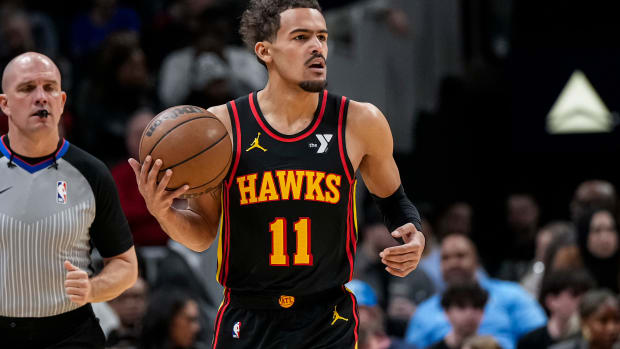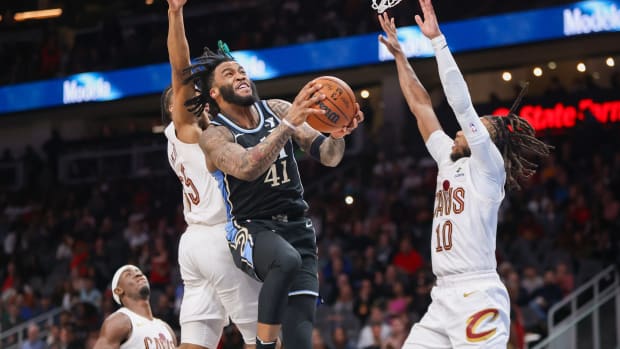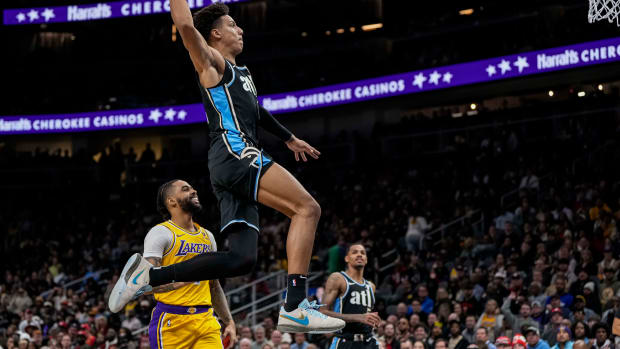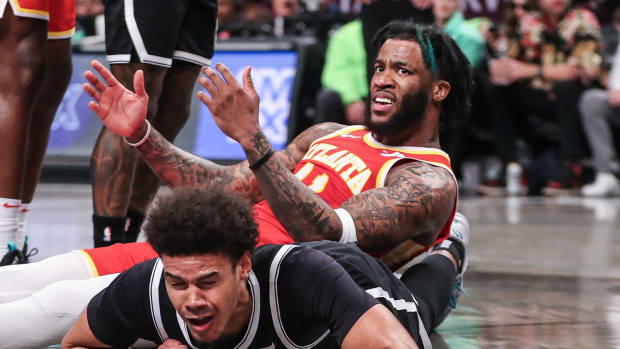Three-Point Play: Huerter Emerges While Kings Catch Fire
This week has provided glimpses at the best and the worst of the Atlanta Hawks. In perhaps their most engaged effort of the season, they earned a thrilling home victory Tuesday night over the Spurs, only to turn around on Wednesday without the legs or the concern to compete with the Chicago Bulls. The two ends of that spectrum converged on Friday as Atlanta fell behind early to the Kings, only to come storming back in the third quarter with the kind of offensive burst that characterize this team at its best. Trae Young finished the night with 30 points and 12 assists while Jabari Parker chipped in 25 – his fourth consecutive game over 18 points.
In the end, Sacramento had the final word, finishing the game on a 21-13 run to outlast the inconsistent Hawks. The Kings closed out the Hawks with a bench-heavy unit on the floor and enjoyed a balanced scoring effort with six players in double-figures. They capitalized on the opportunities Atlanta couldn’t, and a pivotal sequence of two Sacramento 3s and two Hawk turnovers all but ended the home team’s chances of a comeback.
The challenge for up-and-coming teams like the Hawks is learning how to maintain its energy and composure for the full 48 minutes. The ebbs and flows of a single game – let alone an entire season – are enough to rattle groups that haven’t been there before. In most of its losses, Atlanta has either failed to sustain a strong start or taken too many early blows for comeback efforts to pay off. “It takes so much just to get back in the game, you can’t put yourself in a hole in the first half,” Lloyd Pierce said. “We didn’t have the urgency to finish it off.”
“We used so much energy to get ourselves back in,” Young said. “We just lost focus, and that’s something we can’t do, and that’s something that we can learn from this game.”
Here’s what else we can glean from Friday’s game:
Huerter Emerges
The Hawks are designed to operate by committee when Young isn’t on the floor, but have struggled mightily to create offense when he sits. Entering Friday night, Atlanta had scored 109 points per 100 possessions with Young on the floor and a miserable 91.6 points per 100 possessions without him. Even in a mix of heady ball-movers and slashers, Atlanta needs someone to generate offense in bench lineups and provide secondary playmaking next to Young. Rookies Cam Reddish and De’Andre Hunter aren’t ready to step into that role, and Jabari Parker’s promotion to the starting lineup has left the second unit thin on ball-handling and shooting.
Kevin Huerter might be the best candidate to fill that void, offering a combination of shooting and playmaking that no Hawk but Young can match. In what was his best game of the season, he offered an offensive punch Atlanta desperately needed against the Kings. The second-year guard has been on an increasing minutes restriction this season due to a lingering knee injury, but logged a season-high 30 minutes against Sacramento and played a key role in the Hawks’ frantic third-quarter run.
“He’s getting his legs back, but he’s also playing with a different level of physicality,” Pierce said. “The 3 we know he can do, but for him to get in the paint, to absorb and initiate some contact and to be able to go up and finish is what we’re starting to see as he gets his conditioning and his legs back.”
Huerter alleviated some of the pressure from Young’s shoulders with 17 points and four assists off the bench on 6-of-10 shooting and hit multiple 3-pointers for just the second time all season. He finished a pair of shots in the lane and stepped into his shots with newfound lift and confidence:
“Just having the explosiveness to do it,” Huerter said of his offensive verve. “Going to the rim, just not having my legs – I mean, how many shots around the rim did I miss short? And finally today I think I hit a turnaround and just felt more of my legs. And so I think that’s my progression and just game by game the leg’s getting stronger, I’m feeling out the game a little bit more.” As he’s done so, Huerter has begun to display the vision he flashed at moments last season. Where Young has had to do virtually everything without another creator beside him, Huerter offers another viable pick-and-roll option when the two share the floor:
Atlanta has eased Huerter back into the rotation so as not to overwhelm him physically, and he’s gradually settling back into a consistent rhythm. “I’m getting there,” he said. “It’s game by game, just kind of figuring out my spots.” He started the second half in place of Reddish – a possible harbinger of a forthcoming lineup change – and was on the floor during Atlanta’s best stretches of the game. Pierce hinted prior to the game that Huerter could find his way back into the starting lineup once his minutes restriction is lifted, and that change could serve him and Reddish well.
Reddish is probably above his head against opposing starters and has been so ineffective offensively that any possession he uses feels like a waste with so many other options around him; slot him into a more contained role that allows him to play against other backups, and he may find the game slower and easier to digest. Huerter’s shooting makes him a better fit with the starters, while his ability to take pressure off of Young makes the entire offense more dynamic. “We knew coming into the season he’d be basically our secondary facilitator,” Pierce said. “So when he can get downhill and we can put the ball in his hands a little bit more he’s going to create 3s for other guys.”
What Drove the Kings' Red-Hot Shooting?
Through seven games the Hawks had benefitted from unusually cold opponent shooting; Friday night was a regression to the mean. The difference in the game, more than the Hawks’ lack of energy at the start or fizzling fourth quarter, was the Kings’ 18-of-30 shooting on 3-pointers. Sacramento didn’t generate an abnormal amount of triples, but hit them at an unsustainably high rate. The Hawks can at least take solace in the fact that a normal shooting night from their opponent likely would have resulted in a closer game, if not an outright win.
But while their hot shooting isn’t repeatable on a nightly basis, the Kings’ shooting wasn’t as outlandish as the preposterously high percentage might suggest. Sacramento generated clean and comfortable looks, especially in the first half, and save for a few contested makes in the second half, none of its made 3s were surprising in themselves. Poor defense at the point of attack allowed Sacramento’s ball-handlers to consistently reach the second level of Atlanta’s defense, which forced help defenders to crash into the paint to contain drives or tag big men. That left the Kings – even deadeyes like Buddy Hield – wide open from beyond the arc. Trevor Ariza and Bogdan Bogdanović shot a combined 9-of-12 from deep off the bench while Hield, Harrison Barnes, and Nemanja Bjelica made eight of their 16 attempts as a group.
Sacramento’s shooters settled into a rhythm early, which buoyed them for much of the second half as well. Once role players like Ariza and Bjelica find a groove, there simply isn’t much a defense can do to disrupt it, and Atlanta didn’t do enough to force shooters out of their comfort zones. “You get to a shooter, make him put it on the floor. And we got to a shooter and put a hand up,” Pierce said. “So they got into a comfort, and at that point they really got comfortable. So it didn’t matter where we were, they were letting them fly.”
The Kings won’t shoot that way every game and neither will the Hawks’ opponents. Hot shooting teams occasionally leave enemies with no recourse but prayer. But a defense can exert a certain amount of control over the quality of its opponent’s shots, and that can make the difference between winning and losing – or, in Atlanta’s case, mounting a full comeback and falling just short.
Trae Young’s defense
Young will always have defensive issues; a slight 6-foot-2 guard can only be so effective on that end of the floor when he has to shoulder so much on offense. The goal for him and the Hawks will be mitigating the damage he inflicts on that end, and Friday provided a template for how that might be possible.
Atlanta matched Young on point guards for most of last season, even when it was clear he had no chance of defending them. This year, with loftier team ambitions, the Hawks are using Reddish or Huerter on lead guards while hiding Young on the less dynamic member of opposing backcourts. Not only does that spare him from wearing down or being exposed, it allows him to have an impact away from the ball, where he can be active in passing lanes and make rotations as a help defender:
Friday may have been Young’s best defensive game of the season. He had five steals, drew an offensive foul, and made an effort to close out on shooters. He still provides very little resistance on drives and in the post, and commits too many mental lapses for a player with so few defensive tools. He’ll gamble for steals he has no chance of snaring and often just neglects to pick up his man on defense. He often starts plays engaged before bailing out at the first sign of contact:
But so long as Young focuses, competes, and puts himself in the right spots, he can be passable defensively. Given what he can do on the other side of the ball, that’s all the Hawks need him to be.





